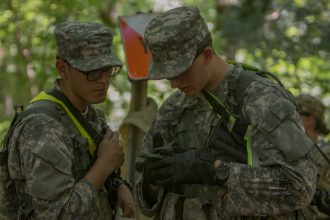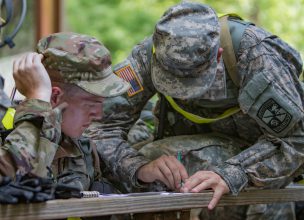FORT KNOX, Ky. — Second Regiment, Basic Camp, Cadets learned how to navigate terrain during Land Navigation training on July 7 at Fort Knox, Kentucky.
“Here at the land navigation course, they learn how to get from point A to point B in the most effective manner, using only a map, protractor and compass,” Texas A&M University Military Science Instructor, Staff Sgt. Calvin Hickman, said.

Cadet Edward Garza (left), from Texas A&M International University, and Cadet Cole Jones (right), from Florida State University, find their next direction of movement by shooting an azimuth during land navigation training on July 7 at Fort Knox, Kentucky. Land navigation teaches Cadets how to get from one place to another with only a map, grid points and a compass. | Photo by Reagan Zimmerman, CST Public Affairs Office
Cadets were paired into buddy teams to complete the training.
“They are paired in twos so they learn to trust their partners,” Sgt. 1st Class Debra Weir, a land navigation grading tent instructor, said. “They learn how to work as a team and they learn how to use [different] skills because some of the Cadets might have done land navigation before. They use those skills to help the other [less experienced] Cadets.”
Cadets come into Basic Camp with varying experience levels. Some Cadets have prior experience from ROTC programs back at their universities, but others have no experience. Those Cadets are here to learn as much as they can from not only the Cadre, but the more experienced Cadets as well.

Cadet Andrew Roccograndi (left), from West Chester University, and Cadet Justin Sisk (right), from the University of Tennessee at Chattanooga, plot points on their map during land navigation training on June 7 at Fort Knox, Kentucky. Land navigation teaches Cadets how to get from one place to another with only a map, grid points and a compass. | Photo by Reagan Zimmerman, CST Public Affairs Office
For Cadets like Matthew Dies, an 18-year-old who just recently graduated from high school, and is attending Georgia Military College, the help is appreciated. Dies looks to his battle buddy to help him overcome obstacles and events at Basic Camp.
“He is actually 22 so he is way older than me and I feel more comfortable [with him],” Dies said. “He has way more experience than I do.”
Even though the experienced Cadets, like Dies’ battle buddy, do lead some of the less experienced Cadets, they are still here to learn.
“They are guiding, but they are also still learning,” Dies said.
Dies believes the experienced Cadets do not know everything and they are constantly learning. That is why they are here at Basic Camp, to learn how to lead.

Georgia Military College Cadets, Treeaunna Whiting (left) and Brianna Batey (right), find their next direction of movement by shooting an azimuth during land navigation training on July 7 at Fort Knox, Kentucky. Land navigation teaches Cadets how to get from one place to another with only a map, grid points and a compass. | Photo by Reagan Zimmerman, CST Public Affairs Office
For University of Florida Cadet, Josiah Hoogerhyde, he looks to experienced Cadets for leadership because he is also less experienced.
“Usually having someone with more experience helps a lot,” Hoogerhyde said. “I think for me, specifically, it depends on how they act with that information.”
Hoogerhyde believes Cadets who help the most lead in a certain way.
“[The best Cadet leaders] are someone who learns to get to your level, being like hey, I have been there, I had to learn this information before,” Hoogerhyde said. “[It is] someone who says, this how you can do it to be a little bit better.”




